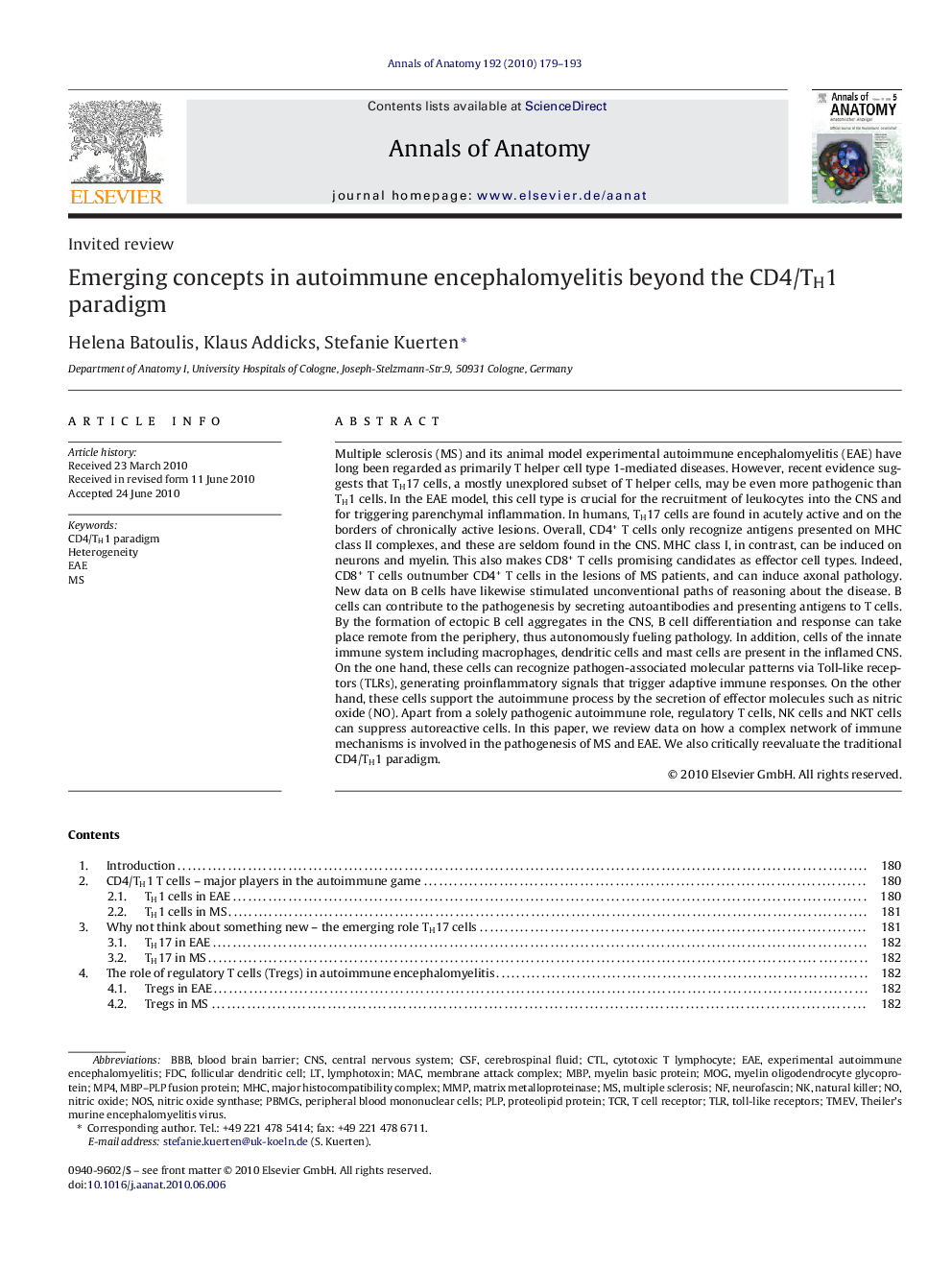| کد مقاله | کد نشریه | سال انتشار | مقاله انگلیسی | نسخه تمام متن |
|---|---|---|---|---|
| 8462212 | 1549026 | 2010 | 15 صفحه PDF | دانلود رایگان |
عنوان انگلیسی مقاله ISI
Emerging concepts in autoimmune encephalomyelitis beyond the CD4/TH1 paradigm
دانلود مقاله + سفارش ترجمه
دانلود مقاله ISI انگلیسی
رایگان برای ایرانیان
کلمات کلیدی
TCrPBMCsTLREAEPLPNOSFDCMBPTMEVMMPCTLMP4MOGnatural killer - (سلول های) کشنده طبیعیProteolipid protein - Proteolipid پروتئینexperimental autoimmune encephalomyelitis - آنسفالومیلیت خودایمنی تجربیCNS - دستگاه عصبی مرکزیBBB - سد خونی مغزیblood brain barrier - سد خونی مغزیperipheral blood mononuclear cells - سلول های تک هسته ای خون محیطیfollicular dendritic cell - سلول های دندریتیک فولیکولارcentral nervous system - سیستم عصبی مرکزیLymphotoxin - لنفو توکسینcytotoxic T lymphocyte - لنفوسیت T سیتوتوکسیکmatrix metalloproteinase - ماتریکس متالوپروتئینازCSF - مایع مغزی نخاعیCerebrospinal fluid - مایع مغزی نخاعیmajor histocompatibility complex - مجموعه سازگاری بافتی اصلیMHC - مجموعه سازگاری بافتی اصلیMultiple sclerosis - مولتیپل اسکلروزیس(ام اس)MAC - مکHeterogeneity - ناهمگونیNeurofascin - نوروفسینNitric oxide - نیتریک اکسیدnitric oxide synthase - نیتریک اکسید سنتازTheiler's murine encephalomyelitis virus - ویروس encephalomyelitis موشی تیلرMyelin basic protein - پروتئین پایه میلینmembrane attack complex - پیچیده حمله غشاءmyelin oligodendrocyte glycoprotein - گلیکوپروتئین الیگودندروسیت میلینT cell receptor - گیرنده سلول TToll-like receptors - گیرنده های پولی مانند
موضوعات مرتبط
علوم زیستی و بیوفناوری
بیوشیمی، ژنتیک و زیست شناسی مولکولی
بیولوژی سلول
پیش نمایش صفحه اول مقاله

چکیده انگلیسی
Multiple sclerosis (MS) and its animal model experimental autoimmune encephalomyelitis (EAE) have long been regarded as primarily T helper cell type 1-mediated diseases. However, recent evidence suggests that TH17 cells, a mostly unexplored subset of T helper cells, may be even more pathogenic than TH1 cells. In the EAE model, this cell type is crucial for the recruitment of leukocytes into the CNS and for triggering parenchymal inflammation. In humans, TH17 cells are found in acutely active and on the borders of chronically active lesions. Overall, CD4+ T cells only recognize antigens presented on MHC class II complexes, and these are seldom found in the CNS. MHC class I, in contrast, can be induced on neurons and myelin. This also makes CD8+ T cells promising candidates as effector cell types. Indeed, CD8+ T cells outnumber CD4+ T cells in the lesions of MS patients, and can induce axonal pathology. New data on B cells have likewise stimulated unconventional paths of reasoning about the disease. B cells can contribute to the pathogenesis by secreting autoantibodies and presenting antigens to T cells. By the formation of ectopic B cell aggregates in the CNS, B cell differentiation and response can take place remote from the periphery, thus autonomously fueling pathology. In addition, cells of the innate immune system including macrophages, dendritic cells and mast cells are present in the inflamed CNS. On the one hand, these cells can recognize pathogen-associated molecular patterns via Toll-like receptors (TLRs), generating proinflammatory signals that trigger adaptive immune responses. On the other hand, these cells support the autoimmune process by the secretion of effector molecules such as nitric oxide (NO). Apart from a solely pathogenic autoimmune role, regulatory T cells, NK cells and NKT cells can suppress autoreactive cells. In this paper, we review data on how a complex network of immune mechanisms is involved in the pathogenesis of MS and EAE. We also critically reevaluate the traditional CD4/TH1 paradigm.
ناشر
Database: Elsevier - ScienceDirect (ساینس دایرکت)
Journal: Annals of Anatomy - Anatomischer Anzeiger - Volume 192, Issue 4, 20 August 2010, Pages 179-193
Journal: Annals of Anatomy - Anatomischer Anzeiger - Volume 192, Issue 4, 20 August 2010, Pages 179-193
نویسندگان
Helena Batoulis, Klaus Addicks, Stefanie Kuerten,